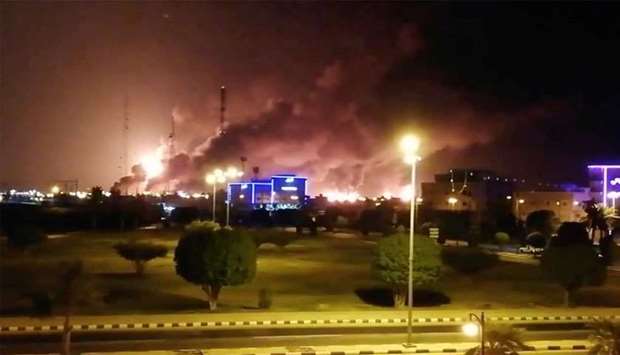*Attack comes as Aramco speeds up plans for IPO, amid regional tensions
Yemen's Houthi group on Saturday attacked two plants at the heart of Saudi Arabia's oil industry, including the world's biggest petroleum processing facility, in a strike that three sources said had disrupted output and exports.
Two sources close to the matter said 5mn barrels per day of crude production had been impacted -- close to half of the kingdom's output or 5% of global oil supply.
The pre-dawn drone attack on the Saudi Aramco facilities set off several fires, although the kingdom, the world's largest oil exporter, later said these were brought under control.
The Houthis' military spokesman, without providing evidence, said drones hit refineries at both Saudi sites, which are over 1,000 km (621 miles) from the Yemeni capital Sanaa, and pledged a widening of assaults on Saudi Arabia.
The Saudi-led coalition launched air strikes on Yemen's northern Saada province, a Houthi stronghold, a witness said. Houthi-run al Masirah TV said the warplanes targeted a military camp.
Saudi state television said exports were continuing, however Aramco has yet to comment since the assault, which the Houthis said involved 10 drones. Authorities have not said whether oil production or exports were affected.
The attacks occurred as Aramco accelerates plans for an initial public offering of the state oil giant to as early as this year, and follow earlier cross-border attacks on Saudi oil installations and on oil tankers in Gulf waters. Saturday's attacks appeared to be the most brazen yet.
"A successful attack on Abqaiq would be akin to a massive heart attack for the oil market and global economy," said Bob McNally, who runs Rapidan Energy Group and served in the US National Security Council during the second Gulf War in 2003.
Abqaiq is 60 km southwest of Aramco's Dhahran headquarters. The oil processing plant handles crude from the world's largest conventional oilfield, the supergiant Ghawar, and for export to terminals Ras Tanura - the world's biggest offshore oil loading facility - and Juaymah. It also pumps westwards across the kingdom to Red Sea export terminals.
Two of the sources said Ghawar was flaring gas after the strikes disrupted gas processing facilities. Khurais, 190 km further southwest, contains the country's second largest oilfield.
Many Western employees of Aramco live in Abqaiq. The US Embassy in Riyadh said it was unaware of any injuries to Americans from the attacks.
The three sources said Aramco had raised emergency levels and was holding a crisis meeting after the assault.
It was the latest in a series of Houthi missile and drone strikes on Saudi cities that had largely been intercepted, but have recently hit targets, including Shaybah oilfield last month and oil pumping stations in May. Both those attacks caused fires but did not disrupt production.
"This is a relatively new situation for the Saudis. For the longest time they have never had any real fears that their oil facilities would be struck from the air," Kamran Bokhari, founding director of the Washington-based Center for Global Policy, told Reuters.
Hours after the Houthi strike in Abqaiq, the Reuters witness said fire and smoke were visible but appeared to have been extinguished by early evening. Earlier video footage verified by Reuters showed bright flames and thick plumes of smoke.
The Saudi interior ministry said Aramco industrial security teams fighting the fires since 4am (0100 GMT) had managed to control them and stop their spread.
The chief of Iran's elite Quds Force, Qassem Soleimani praised the Houthis for their resistance in a Twitter post.
Tensions in the region have escalated in recent months after the United States quit an international nuclear deal and extended economic sanctions on Iran.



